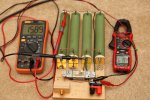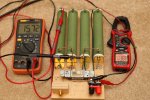So here is the final implementation of my LTO battery box. I made two of these, the one for my son was painted black and the one for my car stayed blue.
Here it is all connected together on the floor. This is just a wiring proof of concept to make sure that everything works as intended:

The battery pack is held into the case with some plumber's strap that is screwed to the bottom panel of the chassis. I also had to move the chassis feet out of the way (closer to the edge) because the screw head interfered with where the batteries would sit.

The bottom of the battery pack received some double stick thermal transfer tape to help hold it in place as well:

Here it is with the battery strapped in place:
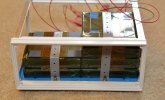
The BMS and charger are attached to what I refer to as the "front" panel. The BMS is held in place only with tape, while the charger is screwed to the panel and I put some thermal paste between the charger and chassis panel. Power entry and camera power connectors are on the opposite panel:
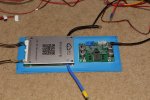
Here it is, almost ready to close up. The charger and BMS are covered with tape and I placed a left over rectangle of plastic between the battery terminals and the BMS to prevent shorting should the battery or BMS/Charger come loose in the chassis.
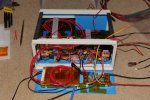
The battery pack for my son's car sits on the rear passenger floor (black carpet), so it got a coat of black truck bed liner to blend in better. The BMS power button wire had to be extended to reach where I needed it to. This lets me remove the cover without worrying about the wires:
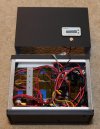
And here it is, all buttoned up and ready for action:

Set to 5.0A charge rate is just about perfect for leaving the BMS on 24/7. When he gets home from work, the battery pack voltage is within a few thousandths of where it was the night before. It seems that the BMS consumes about 1.4w, so I don't have any problem with leaving it on all of the time.
Big thanks to GPak for documenting his work and inspiring my obvious copy-cat implementation. I don't expect any temp-related problems with this battery pack and the batteries themselves should last about 20 years or so. I suspect the batteries might just outlast the car and the rest of the electronics... Should any problems arise with the electronics, I can fix this one myself


